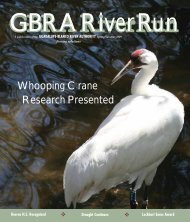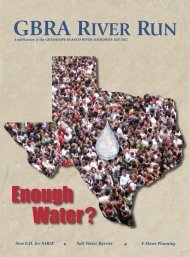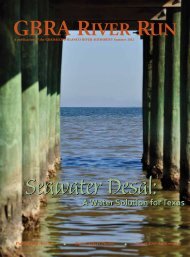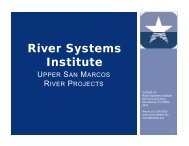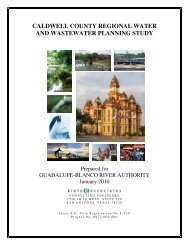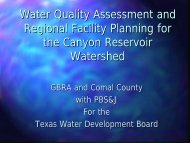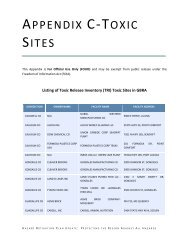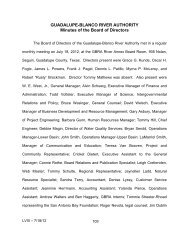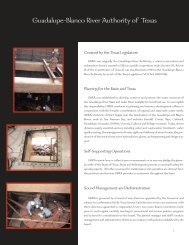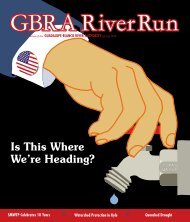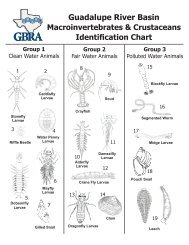Staying Safe Flood Guide - Guadalupe-Blanco River Authority
Staying Safe Flood Guide - Guadalupe-Blanco River Authority
Staying Safe Flood Guide - Guadalupe-Blanco River Authority
Create successful ePaper yourself
Turn your PDF publications into a flip-book with our unique Google optimized e-Paper software.
Nonstructural Management<br />
Federal Insurance Programs<br />
There are two major reasons why the federal government created flood insurance programs.<br />
First, structural management simply cannot protect all areas at risk from<br />
flooding. Second, until Congress created the National <strong>Flood</strong> Insurance Program in 1968,<br />
it was almost impossible to obtain flood insurance. Private insurance firms were not willing<br />
to assume the huge financial risks involved in insuring against catastrophic flood<br />
losses. The NFIP, along with the <strong>Flood</strong> Disaster Protection Act of 1973 and the National<br />
<strong>Flood</strong> Insurance Reform Act of 1994 help ensure that you will be protected from financial<br />
losses caused by flooding.<br />
The National <strong>Flood</strong> Insurance Program<br />
The NFIP, which is administered by the Federal Emergency Management Agency<br />
(FEMA), makes it possible to purchase flood insurance at a reasonable cost. Backed by<br />
the U.S. Government, flood insurance is available to residents in more than 18,500 communities<br />
that currently participate in the NFIP.<br />
In 1999, the Texas Legislature passed House Bill 1018 which requires all counties<br />
and other jurisdictions in the State of Texas to join the NFIP by January 1, 2001.<br />
Counties will be responsible for implementing floodplain management within unincorporated<br />
areas. Cities and other jurisdictions will be responsible for floodplain management<br />
within their boundaries. In return, the NFIP agrees to make flood insurance coverage<br />
available to all residents of the participating communities, including those living in floodplains,<br />
provided those communities adopt and enforce floodplain management criteria to<br />
regulate development in identified flood-prone areas.<br />
Devastating floods occur throughout the U.S. every year. Changing weather patterns,<br />
combined with overdevelopment and clearing of land thereby reducing its natural ability<br />
to absorb water, are increasing the risk of flooding - even for people who don't live near<br />
water. <strong>Flood</strong>ing causes more than $2 billion in property damage each year and losses due<br />
to flooding are not covered under most homeowners or business policies. However,<br />
almost any enclosed building and its contents can be insured against loss from floods,<br />
flood-related erosion and flood-caused mudslides, if a community is participating in the<br />
NFIP.<br />
<strong>Flood</strong>plain Management<br />
Each participating jurisdiction must adopt a floodplain ordinance that regulates development<br />
within the 100-year floodplain, identified as the Special <strong>Flood</strong> Hazard Area on<br />
FEMA flood maps. <strong>Flood</strong> Hazard Boundary Maps and <strong>Flood</strong> Insurance Rate Maps, as well<br />
as information about your local floodplain management regulations, are available from<br />
<strong>Flood</strong>plain Administrators' offices listed on pages 22 and 23 of this booklet. Maps may<br />
also be purchased from FEMA by calling 1-800-358-9616.<br />
Communities may choose to adopt floodplain regulations that are highly restrictive,<br />
but all regulations must include the minimum requirements of the NFIP. The adopted<br />
ordinance names a <strong>Flood</strong>plain Administrator who is responsible for enforcing the ordinance<br />
and issuing floodplain development permits.<br />
18




